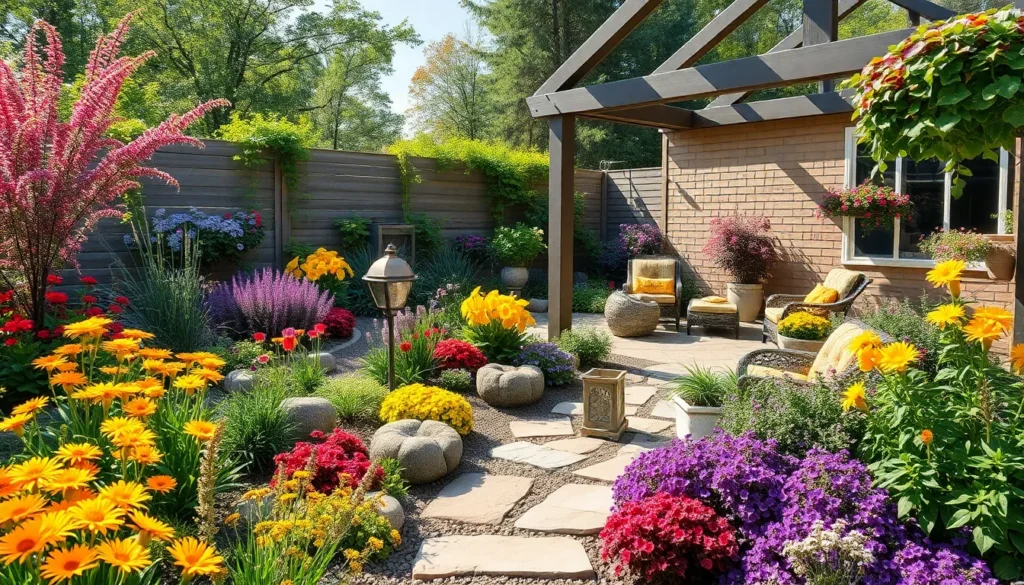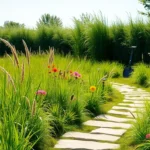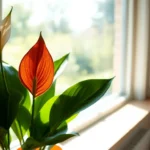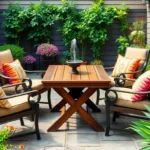We’ve all dreamed of stepping into our backyard and finding a perfectly designed garden sanctuary that reflects our personality and lifestyle. Whether you’re working with a sprawling industry or a compact urban space, the right design ideas can transform any outdoor area into a stunning retreat that enhances your home’s value and your daily life.
Creating a beautiful garden doesn’t require a professional industry architect or an unlimited budget. With thoughtful planning and creative vision, we can design spaces that blend functionality with aesthetic appeal. From choosing the right plants for your climate to incorporating hardscape elements that add structure and interest, successful garden design combines practical considerations with artistic flair.
The best garden designs tell a story and create emotional connections with those who experience them. We’ll explore innovative approaches that maximize your space while minimizing maintenance, ensuring your garden becomes a source of joy rather than stress.
Plan Your Garden Layout Based on Available Space
Smart garden design transforms even the smallest spaces into functional outdoor havens. We’ll guide you through strategic layout planning that maximizes your available area while creating the garden sanctuary you’ve envisioned.
Assess Your Yard Dimensions and Sunlight Patterns
Measure your space accurately to avoid costly plant placement mistakes and overcrowding issues. Use a tape measure to record length, width, and any irregular boundaries, then sketch these dimensions on graph paper or use free garden planning apps like SketchUp or Garden Planner.
Track sunlight patterns throughout different seasons since plant success depends entirely on proper light exposure. Observe your yard for a full week, noting which areas receive full sun (6+ hours), partial sun (3-6 hours), or shade (less than 3 hours) during morning, afternoon, and evening periods.
Document existing features such as trees, slopes, utilities, or structures that impact your design options. Mark underground utilities by calling 811 before digging, and note overhead power lines that might restrict tree planting or tall structure placement.
Consider microclimates within your space, as areas near walls, fences, or large trees create unique growing conditions. South facing walls reflect heat and create warmer zones, while north facing areas stay cooler and receive less direct sunlight throughout the day.
Create Zones for Different Garden Functions
Designate entertainment areas near your home’s main entrance or patio for easy access during gatherings. Position seating areas, fire pits, or outdoor dining spaces in level locations that receive morning or evening sun while avoiding harsh midday exposure.
Establish growing zones based on plant requirements and maintenance needs, grouping vegetables, herbs, flowers, and ornamental plants in separate dedicated areas. Place vegetable gardens in full sun locations with easy water access, while shade tolerant hostas and ferns thrive near building foundations or under tree canopies.
Plan utility zones for composting, tool storage, and maintenance activities in less visible areas of your property. Locate compost bins downwind from entertainment spaces and ensure adequate drainage around storage sheds or garden structures.
Create transition spaces that connect different garden zones using pathways, borders, or decorative elements like arbors and trellises. These connecting features guide visitors through your garden while maintaining visual flow between functional areas.
Consider Traffic Flow and Accessibility
Design main pathways at least 4 feet wide to accommodate wheelbarrows, maintenance equipment, and comfortable two person walking. Use durable materials like flagstone, brick, or decomposed granite that handle weather conditions and heavy use throughout growing seasons.
Install secondary paths connecting garden beds and utility areas using 2-3 foot wide walkways made from stepping stones, mulch, or gravel. These narrower routes provide maintenance access without overwhelming smaller garden spaces or competing with planted areas.
Plan wheelchair accessible routes with gentle slopes under 5% grade and firm, stable surfaces if needed for family members or future mobility considerations. Remove obstacles like low hanging branches and ensure pathway surfaces remain slip resistant during wet conditions.
Position frequently used features within easy reach of main access points to reduce unnecessary foot traffic through planted beds. Place tool storage, water spigots, and compost areas along primary pathways while keeping delicate plants away from high traffic zones.
Choose the Right Plants for Your Climate Zone
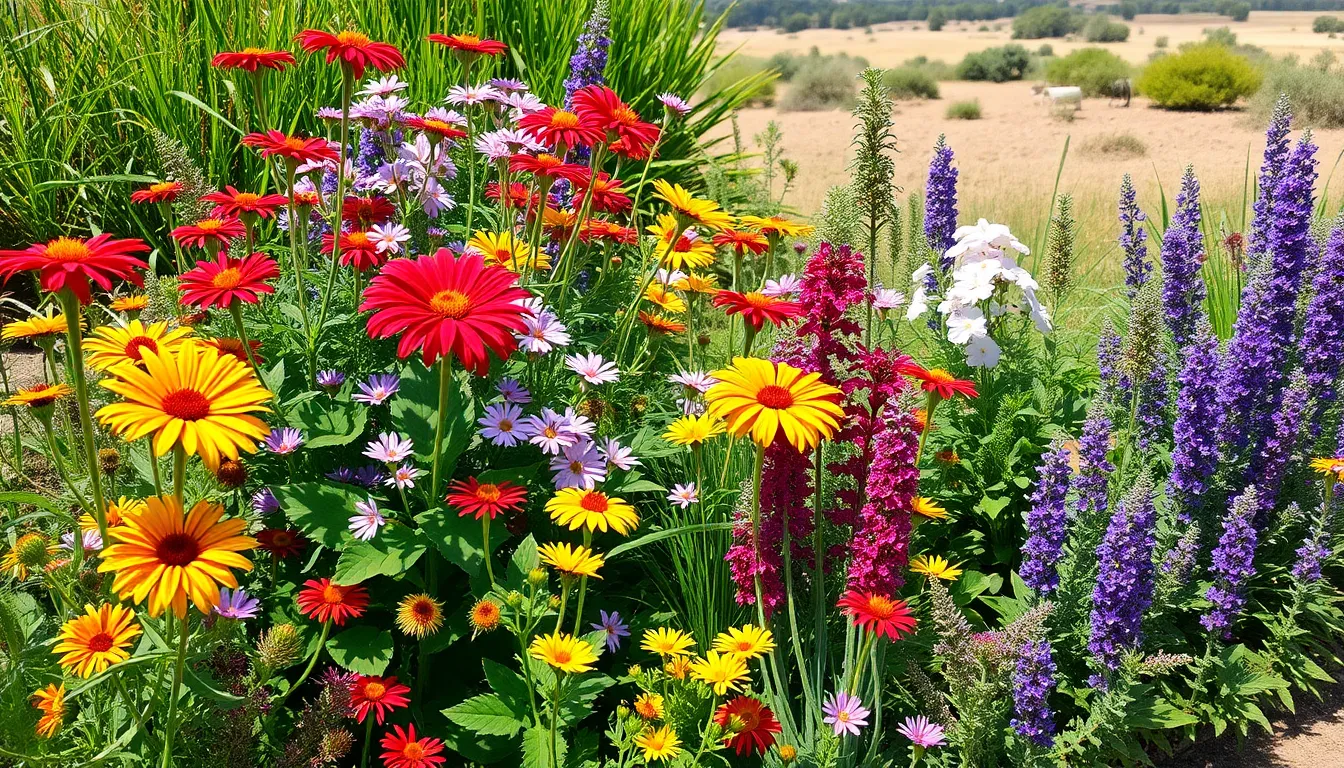
Successful garden design begins with understanding your local climate patterns and selecting plants that’ll naturally thrive in your exact environment. We’ll explore how to match your plant choices with climate zones and environmental conditions for optimal garden success.
Research Native Plants That Thrive Locally
Native plants form the backbone of sustainable garden design because they’ve evolved to flourish in your exact regional conditions. These locally adapted species require less water, fertilizer, and pest control compared to non-native alternatives, making them ideal choices for low-maintenance gardens.
Biodiversity benefits emerge when we incorporate native species, as they support local wildlife including birds, butterflies, and beneficial insects. Native plants create natural habitats that connect your garden to the broader network.
Mediterranean climate gardeners can leverage drought-tolerant natives like agave and Santa Barbara Mexican Bush Sage, which thrive in dry conditions while adding striking architectural elements to industry designs. Desert regions offer succulents and cacti that store water efficiently, while woodland areas provide ferns and wildflowers that prefer shaded, moist conditions.
Research methods include visiting local botanical gardens, consulting with native plant societies, and exploring university extension resources that provide region-exact plant recommendations. Many areas maintain native plant databases that filter options by soil type, sun exposure, and maintenance requirements.
Select Seasonal Varieties for Year-Round Interest
Strategic seasonal planning ensures your garden maintains visual appeal throughout every season, creating ever-changing landscapes that evolve naturally with changing weather patterns. We recommend incorporating plants that peak at different times to maintain continuous color and texture.
Spring bloomers include bulbs like tulips, daffodils, and crocuses that emerge early and signal winter’s end with vibrant colors. Flowering trees such as cherry, magnolia, and redbud provide dramatic spring displays before leafing out completely.
Summer performers cover perennials like black-eyed Susan, purple coneflower, and bee balm that bloom during peak growing season. Annual flowers including marigolds, zinnias, and cosmos provide continuous color from late spring through first frost.
Fall foliage plants such as maples, dogwoods, and sumac create spectacular autumn displays with red, orange, and yellow leaves. Ornamental grasses like fountain grass and feather reed grass add movement and texture during fall months.
Winter structure comes from evergreens including pine, spruce, and holly that maintain their foliage year-round. Deciduous trees with interesting bark patterns or branching structures provide visual interest even when dormant.
Match Plant Requirements to Your Soil Type
Understanding your soil composition directly impacts plant health and garden success, as different species thrive in exact soil conditions ranging from clay to sand to loam. We must evaluate soil drainage, pH levels, and nutrient content before selecting appropriate plants.
Clay soils retain moisture well but can become waterlogged, making them suitable for plants that tolerate wet conditions like astilbe, cardinal flower, and Japanese iris. These heavy soils benefit from organic matter additions that improve drainage and root penetration.
Sandy soils drain quickly and warm up faster in spring, creating ideal conditions for Mediterranean herbs like lavender, rosemary, and thyme. Drought-tolerant perennials including sedum, yarrow, and Russian sage excel in well-draining sandy conditions.
Loamy soils provide the ideal growing medium for most garden plants, offering balanced drainage, nutrient retention, and root development space. Vegetables, roses, and most flowering perennials perform best in loamy conditions with pH levels between 6.0 and 7.0.
Soil testing reveals pH levels, nutrient deficiencies, and organic matter content that guide plant selection and soil amendment decisions. Home testing kits provide basic information, while professional soil tests offer comprehensive analysis including micronutrient levels and exact recommendations for improvement.
Design Focal Points to Create Visual Interest
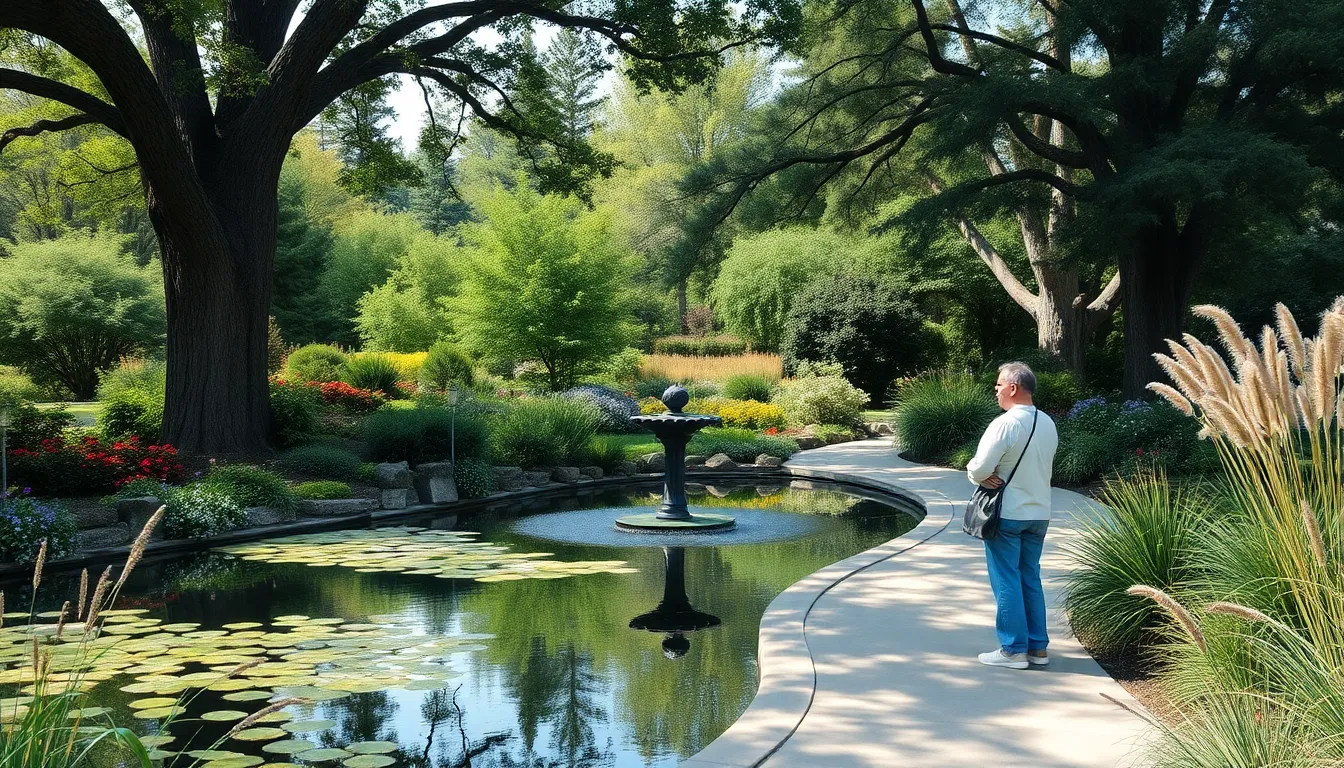
Creating captivating focal points transforms ordinary garden spaces into extraordinary outdoor sanctuaries. Strategic placement of eye-catching elements guides visitors through our garden while establishing visual anchors that define each area’s character.
Install Water Features as Central Elements
Water features serve as natural magnets that draw attention and create peaceful atmospheres in our outdoor spaces. Ponds and fountains generate soothing sounds while producing visually appealing reflections that capture light throughout the day. These elements work particularly well when positioned at the intersection of garden pathways or as endpoints for walking routes.
Meandering paths leading to water features create a sense of discovery and anticipation for visitors exploring our gardens. Curved walkways that gradually reveal fountains or small ponds enhance the element of surprise while encouraging exploration. Water features also support local wildlife like birds and beneficial insects, adding another layer of natural interest to our garden design.
Use Sculptures or Garden Art Strategically
Placing art throughout our garden spaces creates instant conversation starters while reflecting our personal style and interests. Sculptures work best when positioned at natural stopping points along pathways or framed by plantings that complement their scale and material. Consider weather-resistant materials like stone, metal, or ceramic that maintain their appearance through seasonal changes.
Arbors and pergolas provide perfect frameworks for displaying garden art while creating intimate viewing spaces. These structures can showcase hanging sculptures, wind chimes, or climbing plants that change with the seasons. Positioning artwork at varying heights ensures visual interest from multiple viewpoints throughout our garden experience.
Create Height Variation with Trees and Tall Plants
Trees function as living architectural elements that provide vertical drama while offering practical benefits like shade and wind protection. Towering specimens create natural focal points that anchor our garden design and provide backdrop for smaller plantings. Choose trees with interesting bark, seasonal color changes, or unique branching patterns to maximize year-round appeal.
Tall plants and shrubs establish layered compositions that add depth and dimension to our garden spaces. Ornamental grasses, bamboo varieties, and columnar evergreens create vertical accents without requiring the space commitment of full-sized trees. These elements work particularly well for defining property boundaries or screening less attractive views while maintaining our garden’s overall design flow.
Incorporate Pathways and Hardscaping Elements
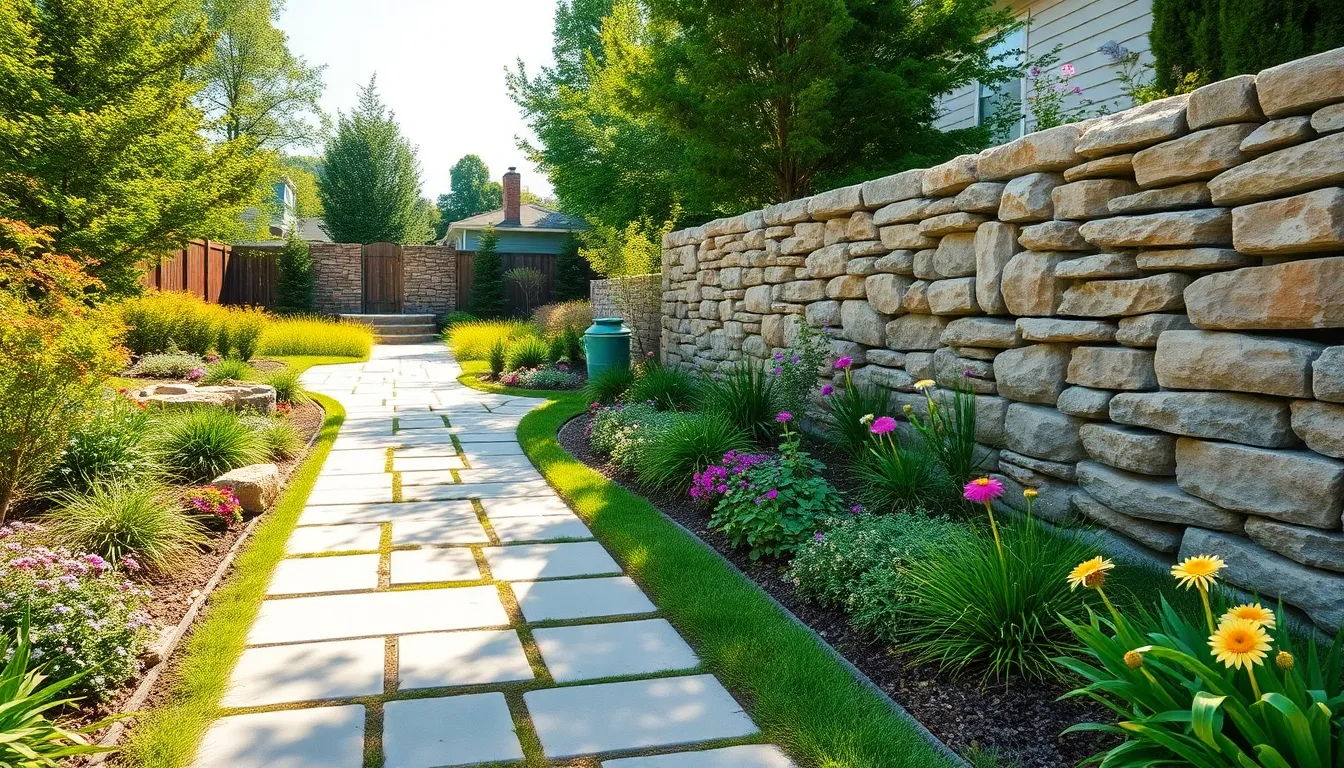
Hardscaping elements transform our garden design into a functional and visually appealing outdoor space. Strategic placement of pathways and structural features creates lasting beauty while solving practical challenges in our industry.
Design Walking Paths with Natural Materials
Natural materials create the most durable and visually appealing pathways for our garden design. Stone pavers and flagstone offer formal elegance while withstanding heavy foot traffic throughout the seasons. Brick pathways provide classic charm and complement traditional garden styles perfectly.
Economical options like mulch and loose gravel deliver excellent drainage while maintaining casual, relaxed aesthetics. These materials work exceptionally well for secondary pathways and informal garden areas. Natural stepping stones combine durability with permeability, allowing rainwater to drain directly into the soil beneath.
Wood planks bring warmth and natural texture to our pathway design, particularly effective in woodland or cottage garden settings. Gravel paths cost less than other materials while providing superior drainage for areas with heavy rainfall or clay soil conditions.
Add Retaining Walls for Sloped Areas
Retaining walls solve erosion problems while creating level planting areas in challenging terrain. These structures stabilize sloped sections of our garden and prevent soil loss during heavy rains or seasonal weather changes.
Stone retaining walls blend seamlessly with natural landscapes and provide long lasting structural support. Brick walls offer classic appeal and work well with traditional architectural styles throughout our outdoor space. Concrete block construction delivers modern functionality while maintaining cost effectiveness for larger projects.
Proper retaining wall installation creates terraced planting opportunities that maximize our growing space. These level areas accommodate plants that struggle on slopes while improving water retention and soil stability.
Install Patios and Seating Areas
Patio construction using pavers, poured concrete, or natural stone creates weather resistant surfaces for outdoor living. These durable materials withstand seasonal temperature changes while maintaining their appearance year after year.
Built in stone seating integrates seamlessly with our hardscape design while providing permanent gathering spaces. Outdoor furniture placement on properly constructed patios creates flexible entertaining areas for family and guests. Bench installation along pathways offers rest stops while improving the overall garden experience.
Modern touches like Corten steel or galvanized steel edging add contemporary flair to traditional patio designs. Solar or electric lighting installation highlights our hardscape features while extending evening enjoyment of our outdoor space.
Select a Color Scheme That Complements Your Home
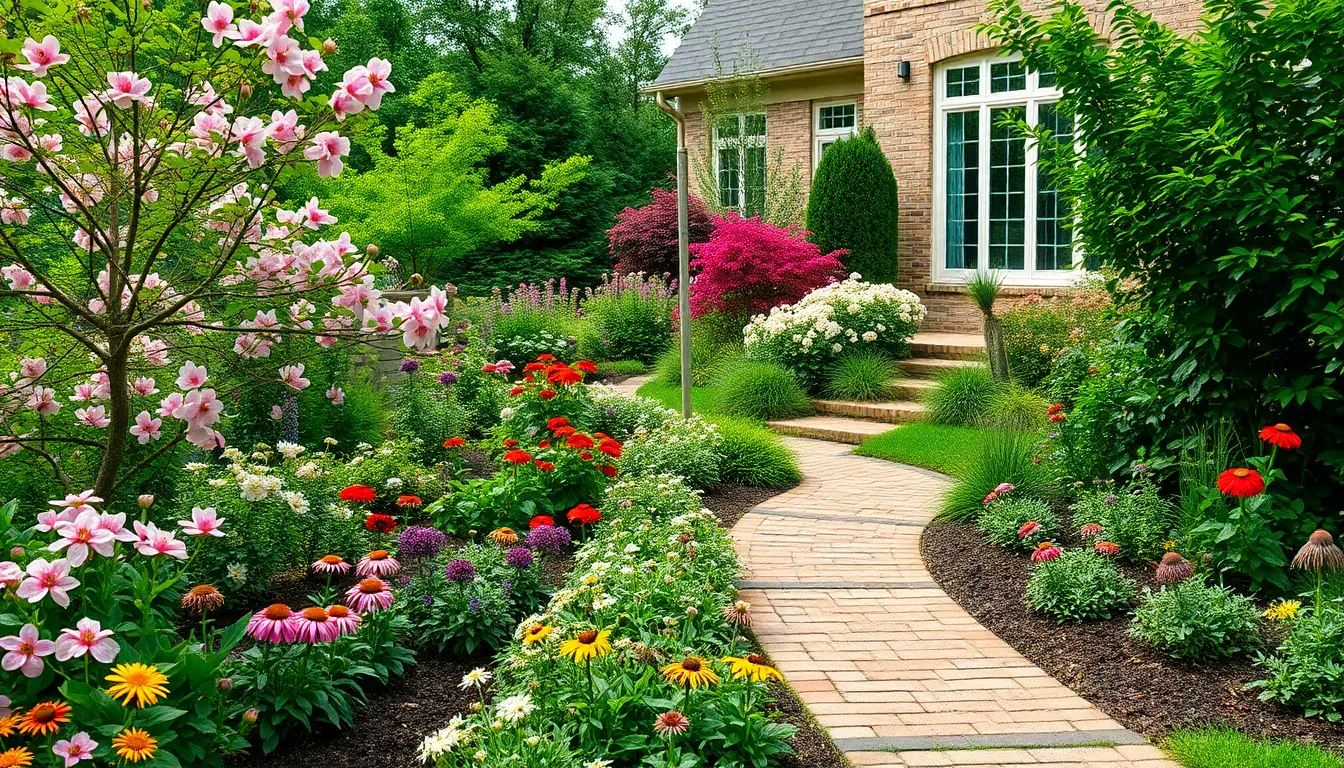
We’ll create visual harmony by choosing colors that work seamlessly with your house’s exterior design. Building a cohesive color palette ensures your garden enhances rather than clashes with your home’s architectural style.
Choose Harmonious Plant Colors
Plant colors should follow the color wheel principles to create visually appealing combinations throughout your garden spaces. We recommend selecting blooms and foliage that complement your home’s siding, trim, and roof colors for maximum impact.
Consider your house’s dominant colors when choosing flowering plants like roses, hydrangeas, or seasonal annuals. Cool tones such as blues and purples work beautifully with white or gray exteriors, while warm oranges and yellows complement brick or earth-tone homes.
Foliage colors contribute significantly to your garden’s overall palette beyond just flower selections. Green varieties range from deep emerald to silvery sage, each offering different visual effects against your home’s backdrop.
Coordinate Hardscaping Materials
Hardscaping materials should match your home’s architectural style to maintain design consistency across your entire property. Stone, brick, or wood elements work best when they echo materials already present in your house’s construction or exterior features.
Pathway materials like flagstone complement homes with natural stone foundations, while brick walkways enhance colonial or traditional architectural styles perfectly. Modern homes benefit from clean concrete pavers or sleek metal edging that reflects contemporary design principles.
Retaining walls and garden borders should use similar materials to your home’s foundation or exterior accents for seamless integration. We’ve found this approach creates visual unity that makes both house and garden appear more polished and intentional.
Plan for Seasonal Color Changes
Seasonal planning ensures your garden maintains visual interest and color harmony throughout the entire year. We strategically incorporate plants that bloom during different seasons to create continuous color displays that complement your home’s permanent features.
Spring flowering trees like dogwoods or cherry blossoms provide early season color before perennials begin their growing cycle. Summer perennials such as coneflowers and black-eyed Susans offer vibrant blooms during peak growing months.
Fall brings opportunities for berry-producing shrubs like viburnum or winterberry that add seasonal color while supporting local wildlife. Winter interest comes from evergreen plants and ornamental grasses that maintain structure and subtle color during dormant months.
| Season | Color Sources | Examples |
|---|---|---|
| Spring | Flowering trees | Dogwoods, cherry blossoms |
| Summer | Vibrant perennials | Coneflowers, black-eyed Susans |
| Fall | Berry-producing shrubs | Viburnum, winterberry |
| Winter | Evergreens and grasses | Pine, ornamental grasses |
Add Functional Elements for Year-Round Enjoyment
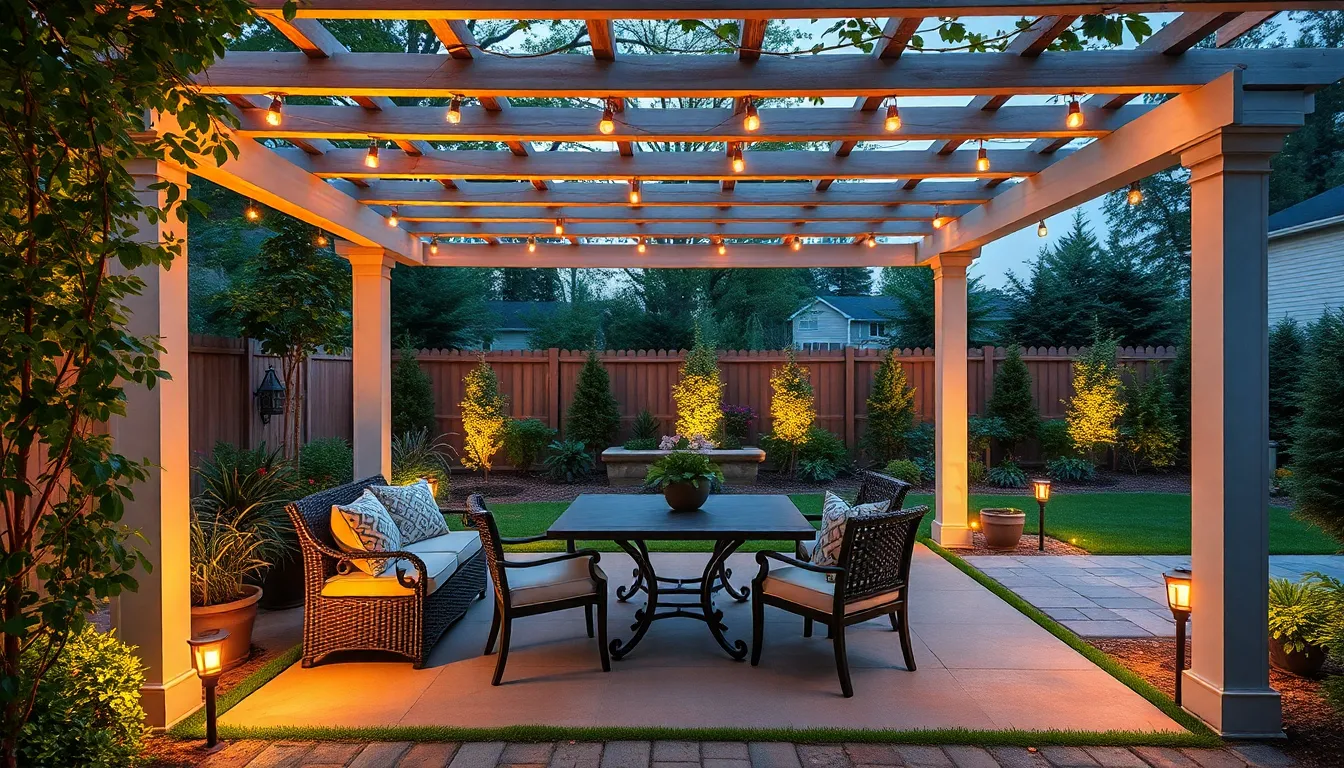
We’ll transform your garden space into a versatile outdoor sanctuary that serves you throughout every season. Strategic functional elements ensure your garden remains an active part of your lifestyle regardless of weather conditions.
Install Proper Garden Lighting
Solar powered lights offer an eco-friendly solution that illuminates pathways while reducing energy costs throughout the year. We recommend placing these fixtures along main walkways and near focal points to create safe navigation routes after dark. String lights add magical ambiance for evening gatherings and extend outdoor entertaining hours well into the night.
Industry lighting highlights architectural features and creates dramatic shadows that showcase your garden’s best elements. We suggest installing low voltage LED fixtures around water features, sculptures, and specimen plants to maintain visual interest during darker months. Motion sensor lights near storage areas and seating zones provide practical illumination when you need it most.
Create Storage Answers for Tools
Tool sheds keep gardening equipment organized and protected from weather damage year round. We advise selecting weather resistant materials like cedar or metal that withstand seasonal temperature changes and moisture exposure. Proper ventilation prevents rust and mildew while maintaining tool longevity.
Hidden storage compartments in benches or planters maximize space efficiency while maintaining clean sight lines. We recommend waterproof containers built into seating areas for small hand tools, gloves, and seasonal supplies. Vertical storage systems on shed walls optimize available space and keep frequently used items easily accessible.
Wall mounted tool organizers prevent clutter and make seasonal garden transitions smoother. We suggest installing pegboards or rail systems that accommodate tools of various sizes and shapes. Dedicated spaces for hoses, extension cords, and seasonal decorations streamline garden maintenance tasks.
Design Areas for Outdoor Dining
Durable patio sets withstand various weather conditions while providing comfortable spaces for meals and relaxation. We recommend selecting materials like teak, aluminum, or weather resistant wicker that maintain appearance through seasonal changes. Proper sizing ensures adequate seating for your typical gathering sizes.
Shade structures like pergolas or gazebos create comfortable dining environments during hot summer months. We suggest incorporating adjustable shade options such as retractable awnings or removable canopies for seasonal flexibility. Built in benches around fire pits extend dining seasons into cooler months.
Outdoor kitchen additions with grills and prep areas enhance dining experiences throughout the growing season. We recommend weatherproof storage for cooking utensils, plates, and serving pieces to streamline outdoor meal preparation. Counter space near cooking areas provides convenient food preparation zones that complement your indoor kitchen facilities.
Implement Sustainable Gardening Practices
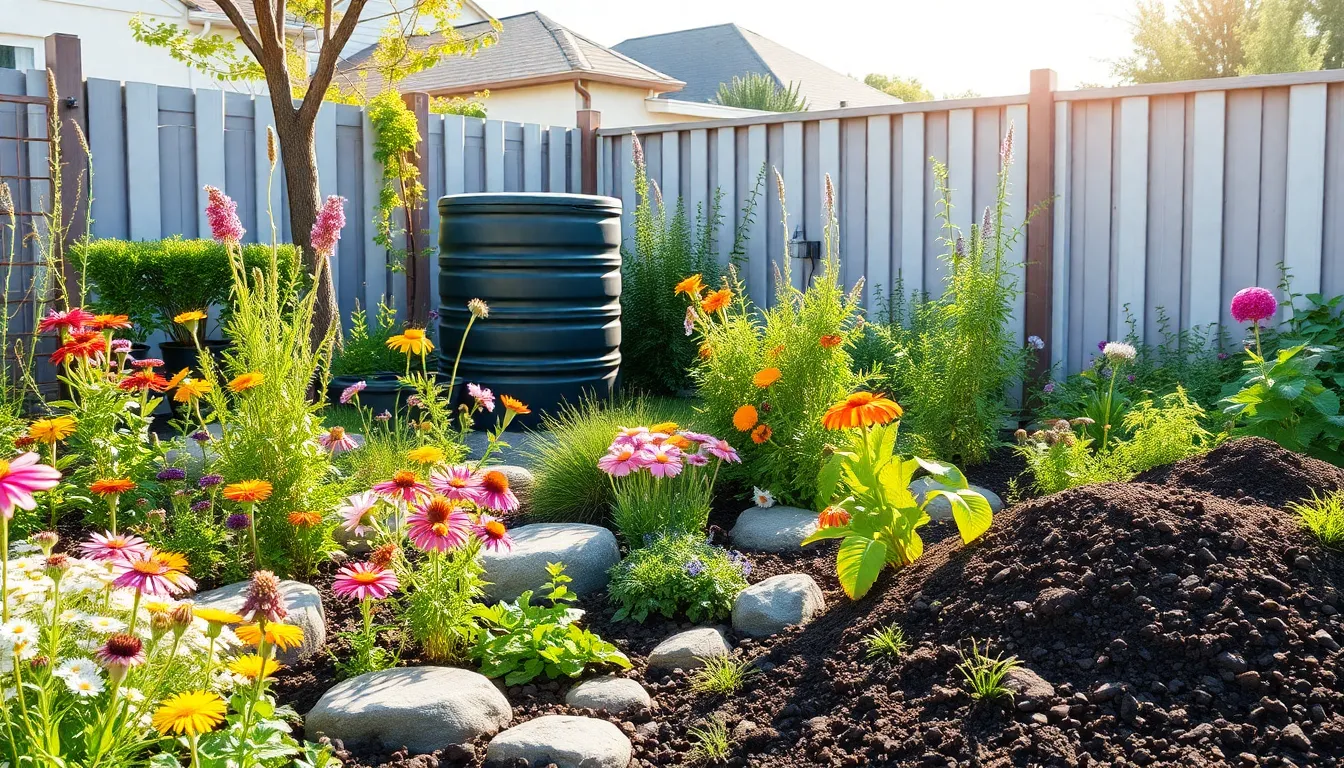
Sustainable gardening transforms your outdoor space into an environmentally conscious haven while reducing maintenance and utility costs. These eco-friendly approaches help us create thriving gardens that support local ecosystems and conserve natural resources.
Design Rain Gardens and Water Collection Systems
Rain gardens serve as biological filters that naturally clean stormwater runoff while adding visual interest to your industry. We recommend positioning these shallow depressions in areas where water naturally collects, allowing them to capture and slowly infiltrate rainwater rather than letting it rush into storm drains.
Strategic placement near downspouts or low-lying areas maximizes their effectiveness in managing excess water during heavy rainfall. Native sedges, wildflowers, and moisture-loving perennials thrive in these conditions while requiring minimal maintenance once established.
Water collection systems complement rain gardens by capturing precious rainwater for later irrigation use. Installing rain barrels or cisterns reduces our dependence on municipal water supplies while providing a sustainable source for garden watering needs.
Create Composting Areas
Composting areas transform organic waste into nutrient-rich soil amendments that eliminate the need for chemical fertilizers. We can designate a corner of our garden for composting using materials like food scraps, fallen leaves, and grass clippings to create this valuable resource.
Simple bin systems or tumbler composters accelerate the decomposition process while keeping organic materials contained and organized. Animal manure from herbivorous animals adds nitrogen-rich components that enhance the composting mixture’s nutritional value.
Finished compost improves soil structure and provides slow-release nutrients that support plant health naturally. This organic approach maintains soil vitality while reducing household waste that would otherwise end up in landfills.
Choose Low-Maintenance Plant Options
Pollinator-friendly plants create vibrant ecosystems that support bees, butterflies, and other beneficial insects while requiring minimal intervention. We can select native flowering species that bloom throughout different seasons to provide consistent nectar sources for pollinators.
Drought-resistant ground covers like Ajuga and Lilyturf reduce the need for frequent watering and mowing while suppressing weeds naturally. These hardy plants establish dense coverage that minimizes maintenance tasks while preserving soil moisture.
Edible gardens combine functionality with beauty by incorporating fruits, vegetables, and herbs into our industry design. Berry bushes, herb spirals, and vegetable beds provide fresh produce while contributing to the garden’s overall aesthetic appeal and reducing grocery expenses.
Plan for Future Growth and Maintenance
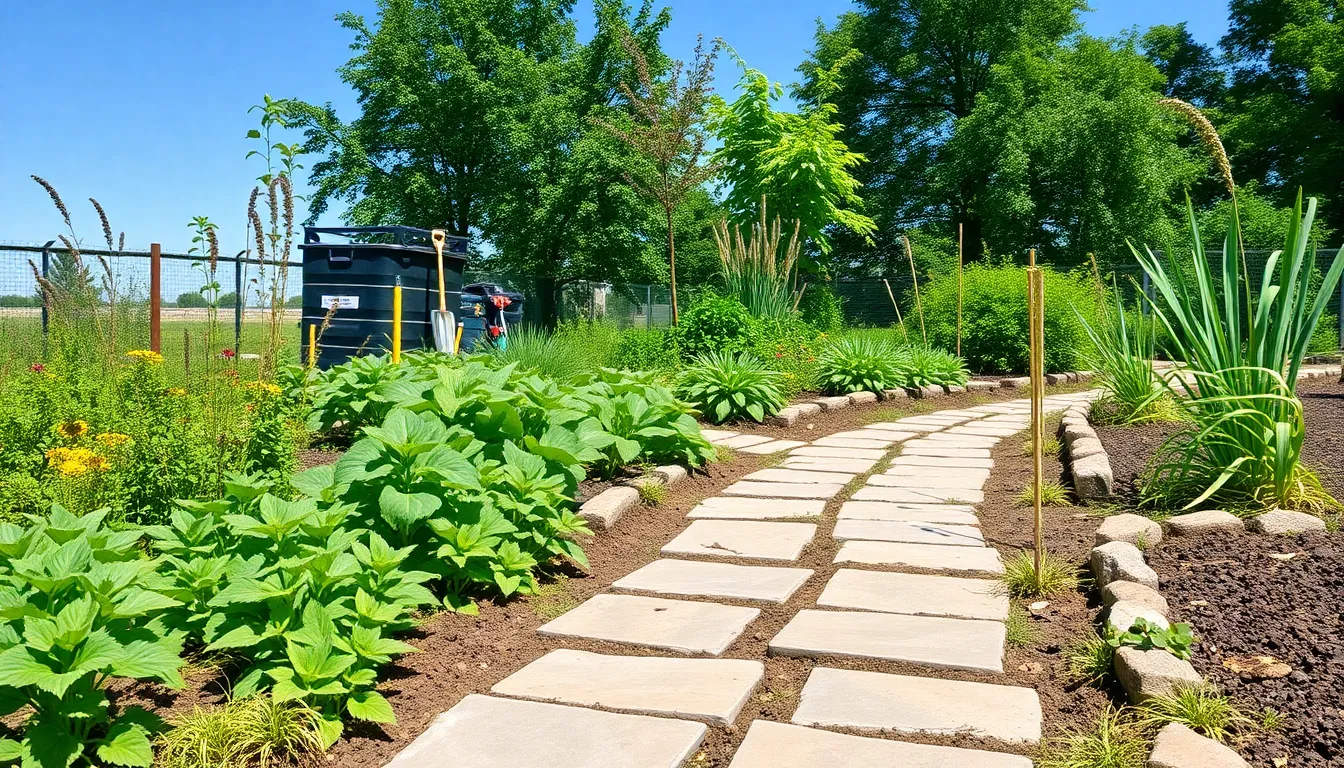
Successful garden design extends far beyond the initial planting phase and requires thoughtful consideration of how your outdoor space will evolve over time. Smart planning now prevents costly redesigns later while ensuring your garden remains manageable and beautiful for years to come.
Leave Space for Plant Maturation
Proper spacing prevents overcrowding that leads to reduced plant health and increased maintenance requirements down the road. Research the mature size of each plant before positioning them in your garden beds, allowing adequate room for their full growth potential. Small saplings might look sparse initially, but they’ll fill out beautifully when given appropriate space to develop their natural form.
Dwarf varieties offer excellent answers for smaller gardens where space constraints limit full-size plant options. Consider the three-dimensional growth patterns of your plants, accounting for both width and height at maturity. Root systems also require sufficient underground space to establish properly without competing for nutrients and water resources.
Design Accessible Maintenance Areas
Create pathways that allow easy access to all parts of the garden for pruning, watering, and other essential maintenance tasks throughout the growing season. Wide walkways accommodate wheelbarrows, garden carts, and other maintenance equipment while preventing soil compaction in planting beds. Strategic placement of stepping stones or permanent paths ensures you can reach every corner of your garden without damaging delicate plants.
Maintenance zones should include designated areas for compost bins, tool storage, and potting activities near your main garden beds. Position water sources conveniently throughout the garden to minimize dragging heavy hoses across planted areas. Plan for adequate lighting in maintenance areas to extend your gardening activities into evening hours when temperatures are more comfortable.
Consider Long-Term Care Requirements
Choose plants that are suitable for your climate and can thrive with minimal long-term care, reducing both maintenance time and gardening expenses. Drought-tolerant plants significantly decrease watering requirements once established, making them ideal choices for sustainable garden design. Native species naturally adapt to local conditions and require fewer interventions compared to exotic varieties that struggle in unfamiliar environments.
Perennial plants offer better long-term value than annuals, returning year after year without replanting costs and effort. Select disease-resistant cultivars to minimize the need for chemical treatments and ongoing plant replacements. Group plants with similar water and care requirements together to streamline maintenance routines and ensure optimal growing conditions for each garden zone.
Conclusion
We’ve explored the essential elements that transform any outdoor space into a thriving garden sanctuary. From strategic planning and plant selection to incorporating hardscaping features and sustainable practices each decision contributes to creating your personalized outdoor haven.
Remember that successful garden design isn’t about perfection—it’s about creating a space that reflects your lifestyle and brings you joy. Whether you’re working with a small balcony or sprawling backyard the principles we’ve discussed will help you build a garden that evolves and flourishes over time.
Your garden journey starts with a single step. Take what resonates with your vision carry out these ideas gradually and watch as your outdoor space transforms into the sanctuary you’ve always envisioned.
Frequently Asked Questions
Can I create a beautiful garden without hiring a professional landscaper?
Yes, you can absolutely create a stunning garden without professional help. The key is thoughtful planning, creativity, and understanding your space. Focus on selecting appropriate plants for your climate zone and incorporating simple hardscape features. With proper research and gradual implementation, you can design a personalized garden sanctuary that reflects your style and needs while staying within your budget.
How do I start planning my garden layout for a small space?
Start by measuring your yard dimensions and tracking sunlight patterns throughout the day. Document existing features and identify microclimates in your space. Even the smallest areas can be transformed into functional outdoor havens by creating distinct zones for different purposes, such as entertainment areas, growing zones, and utility spaces for maintenance activities.
What plants should I choose for my climate zone?
Select plants that are native to your region or well-adapted to your local climate patterns. Native plants require less maintenance, support local wildlife, and are more likely to thrive in your environment. Consider your soil type and seasonal planning to ensure year-round visual interest with plants that bloom at different times throughout the year.
How important are pathways and hardscaping in garden design?
Pathways and hardscaping elements are crucial for both functionality and aesthetics. Use natural materials like stone pavers, brick, or gravel for walking paths. Consider retaining walls for sloped areas to prevent erosion, and incorporate patios and seating areas with durable materials. These features enhance accessibility and create structure in your garden design.
What are some sustainable gardening practices I can implement?
Implement rain gardens and water collection systems to manage stormwater and conserve water. Create composting areas for nutrient-rich soil amendments, choose low-maintenance pollinator-friendly plants, and incorporate edible gardens. These practices transform your outdoor space into an environmentally conscious haven while reducing maintenance costs and supporting local ecosystems.
How do I ensure my garden has year-round appeal?
Plan for seasonal interest by selecting plants that provide color and texture throughout the year. Include spring flowering trees, summer perennials, fall foliage plants, and winter evergreens. Add functional elements like proper garden lighting, outdoor dining areas, and storage solutions to extend the enjoyment of your outdoor space beyond the growing season.
What should I consider for future garden maintenance?
Plan for future growth by providing proper spacing for plants to prevent overcrowding. Choose low-maintenance options like drought-tolerant and native species, and prioritize perennials over annuals for sustainability. Ensure easy access for maintenance tasks and select plants that require minimal long-term care to keep your garden manageable as it matures.

